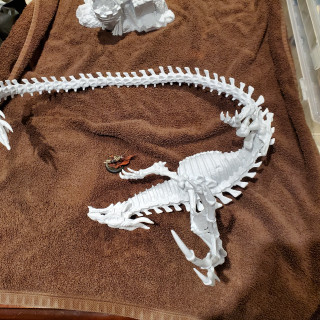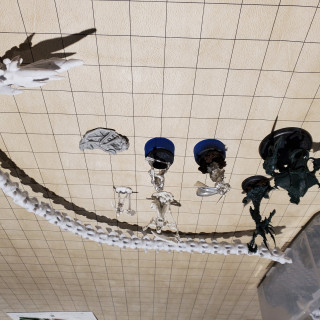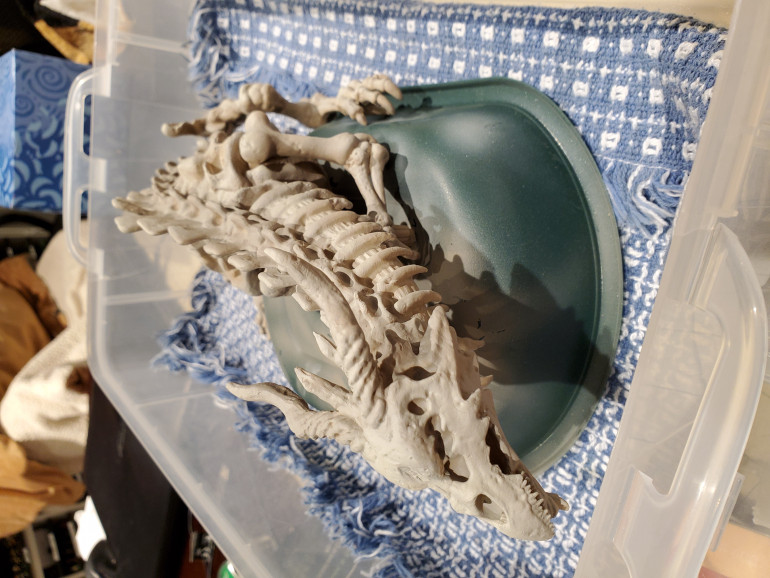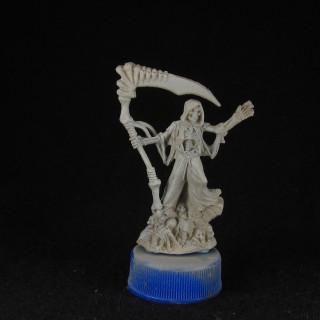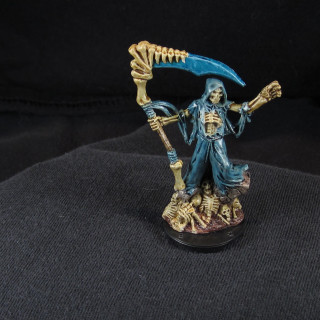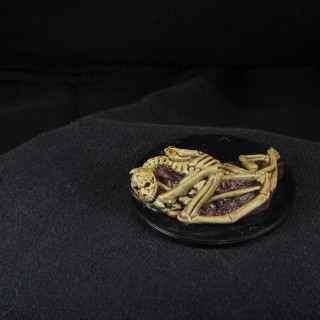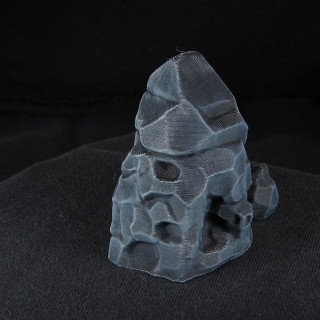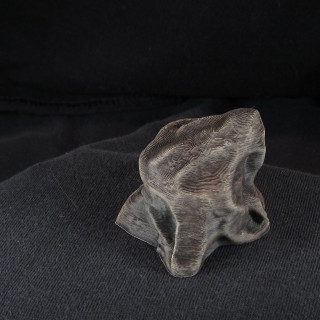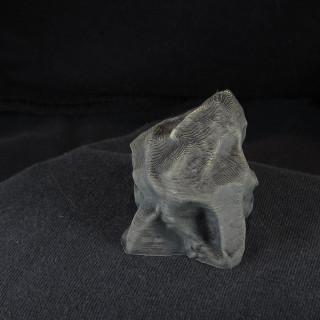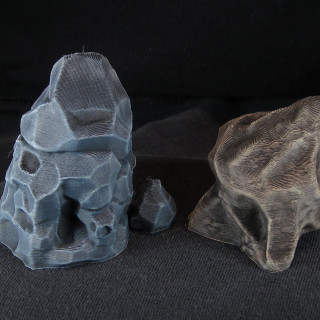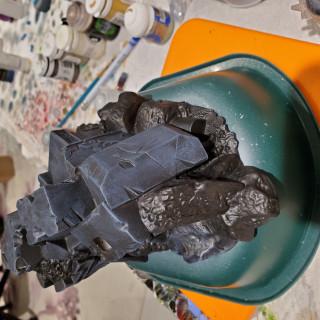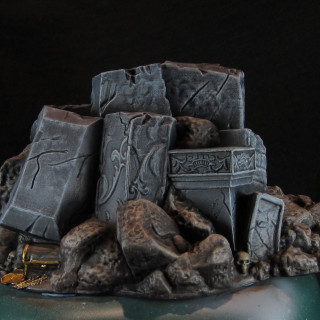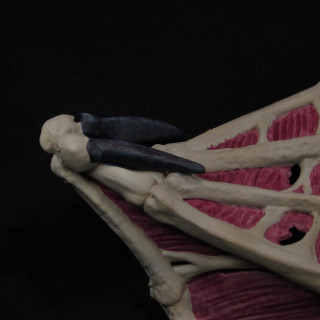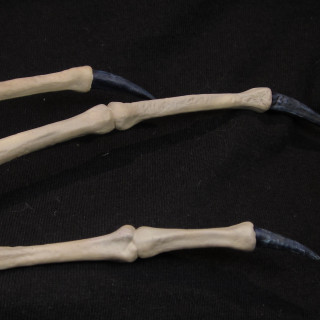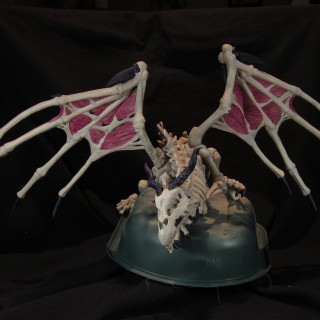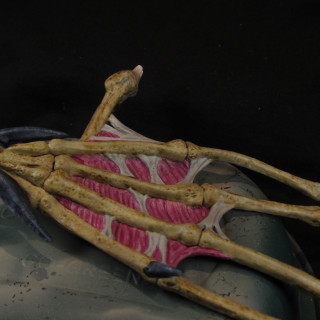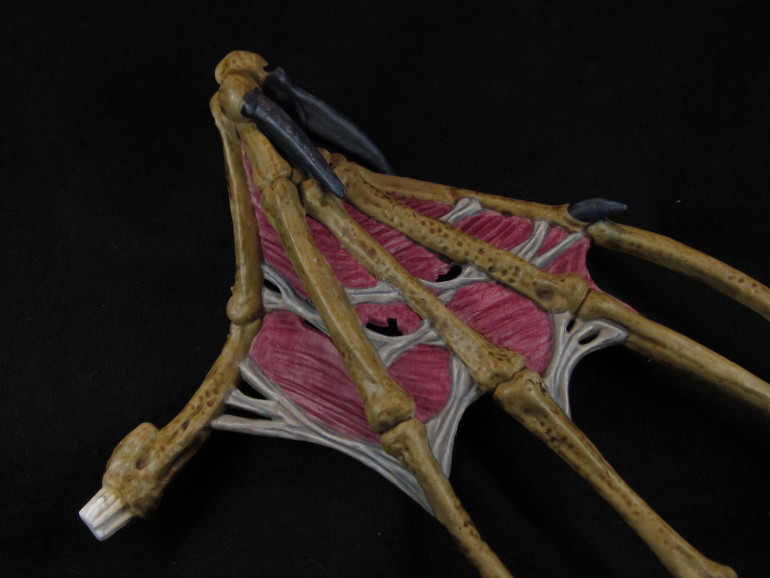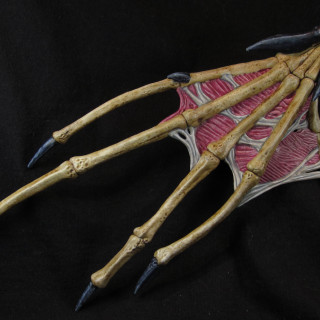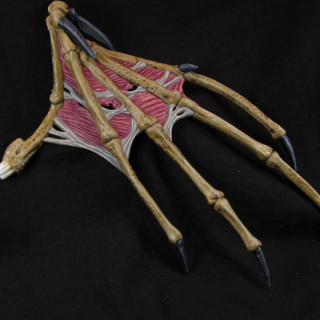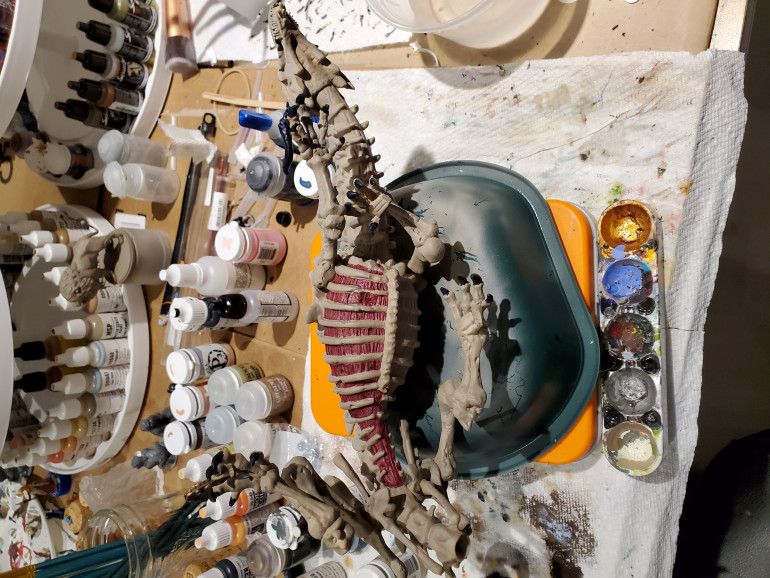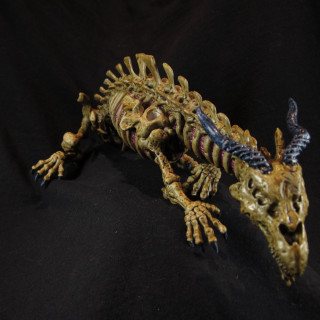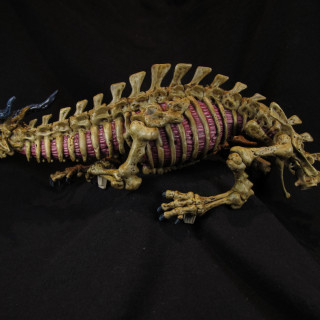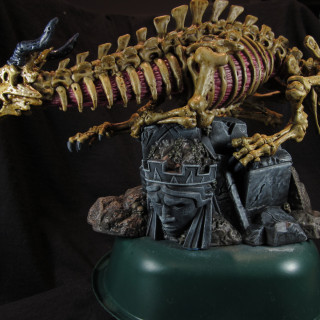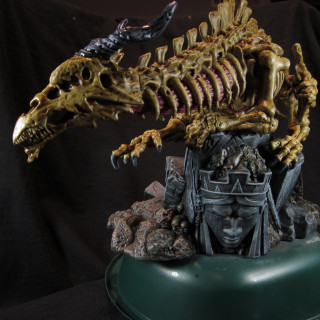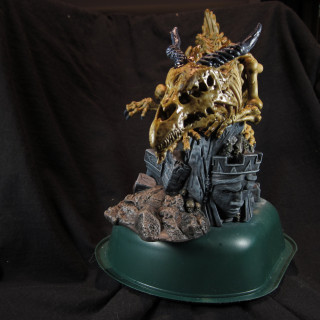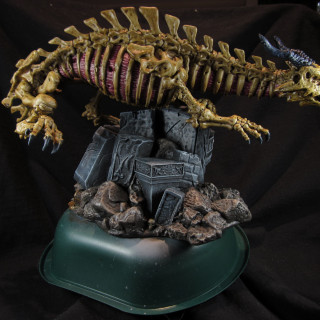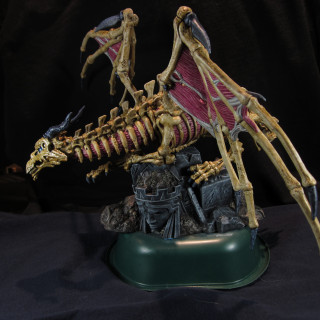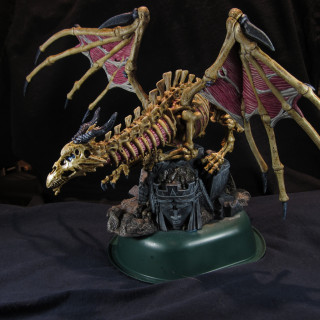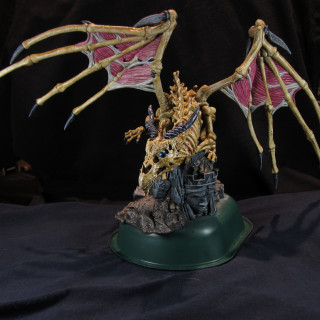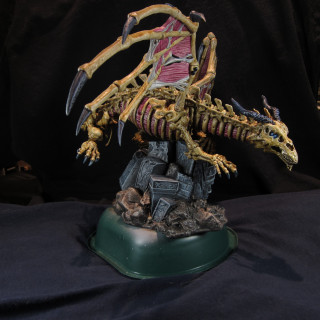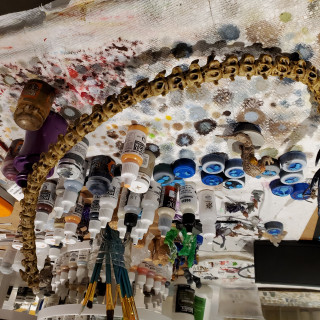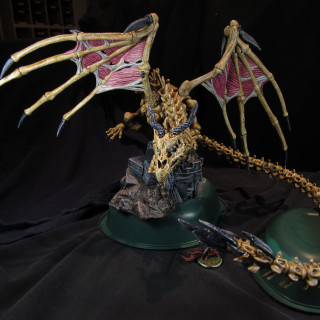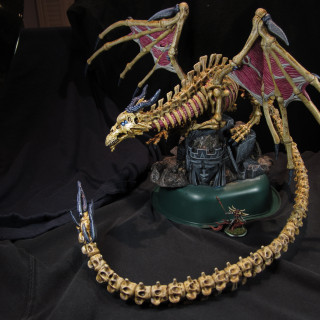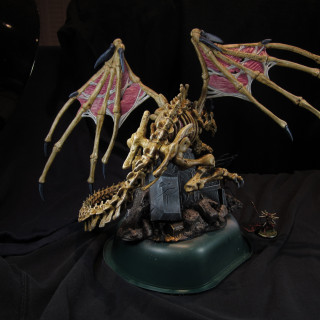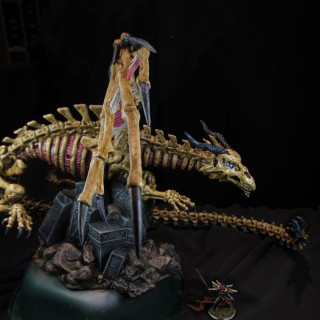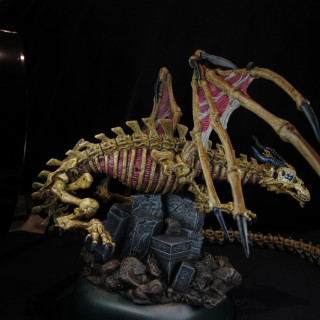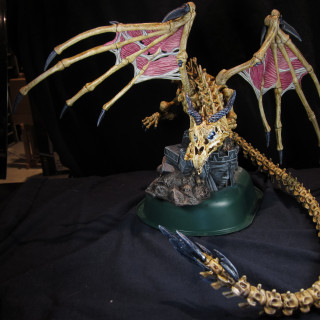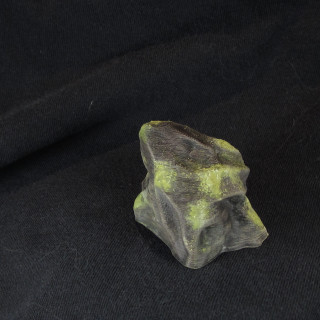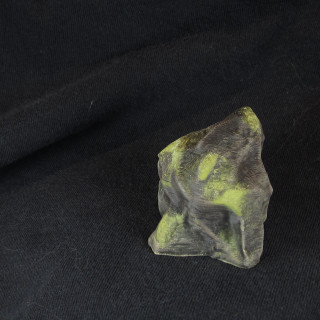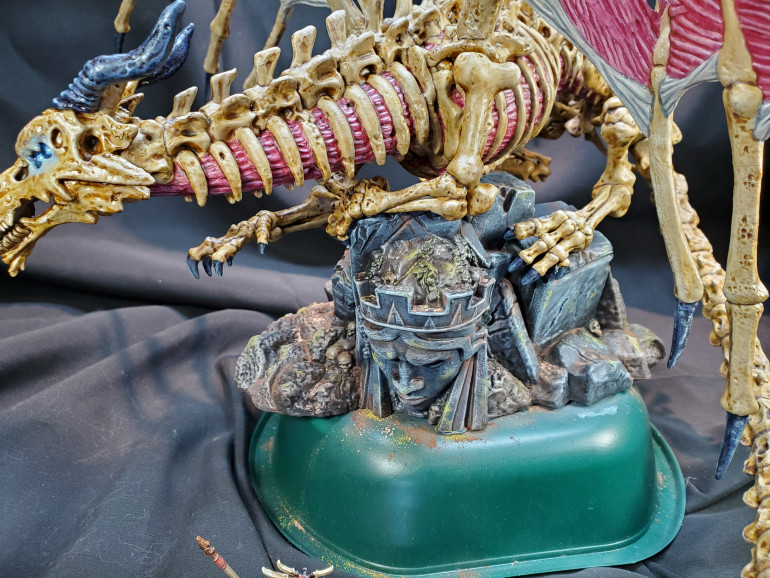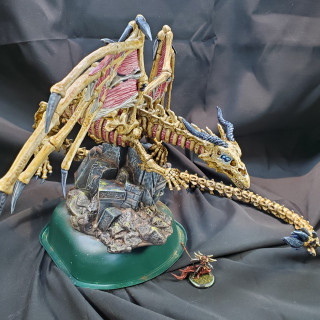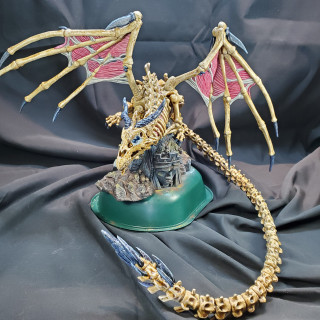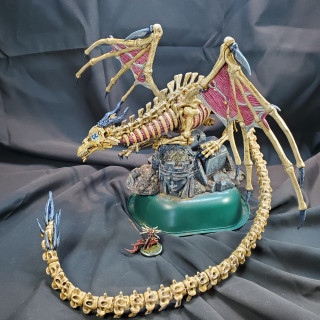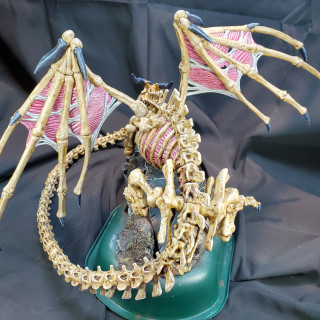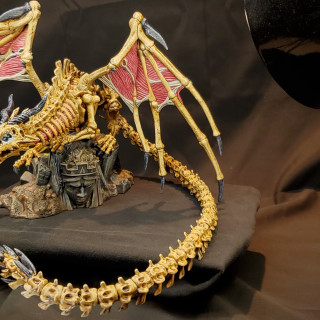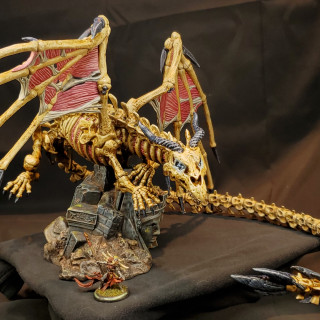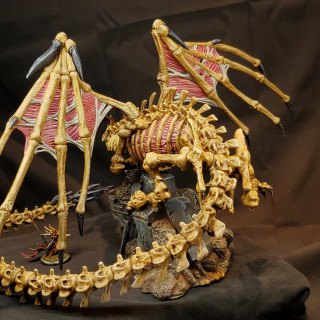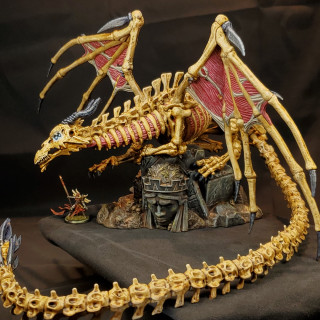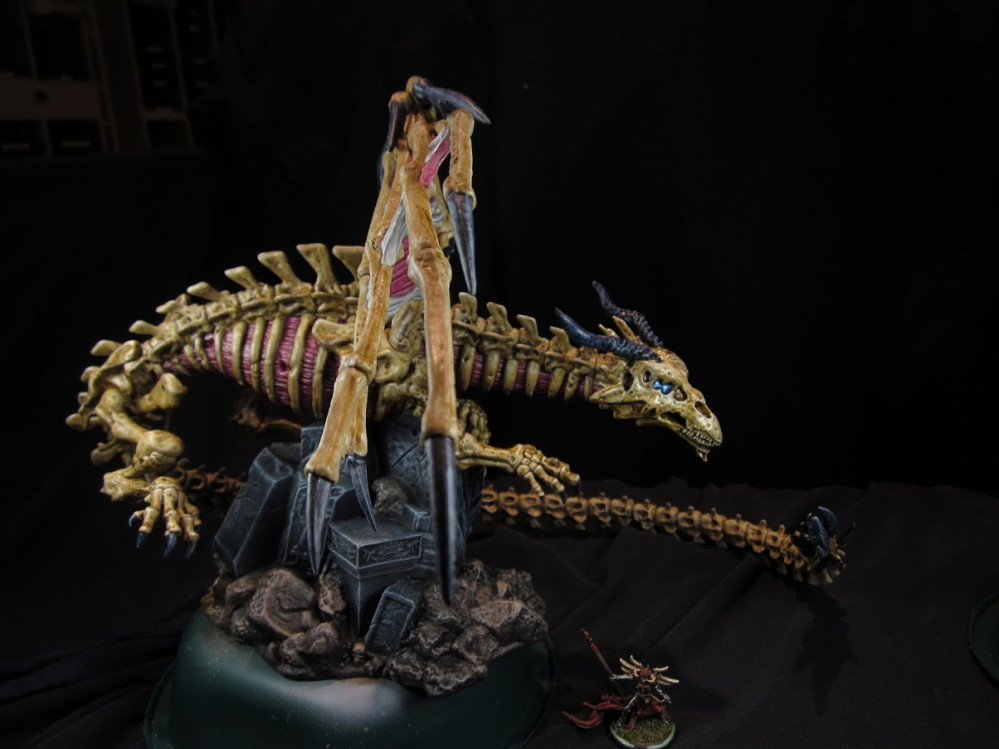
I like big bones and I cannot lie….Kaladrax
Recommendations: 270
About the Project
This project was a coronavirus quarantine challenge from my wife, for the month of May: paint Kaladrax, which we got from Reaper's Bones 1 kickstarter so many years ago and was still in pieces in a box in the basement. It also doubles as my painting challenge for the month from Ghool's patreon.
Related Company: Reaper Miniatures
Related Genre: Fantasy
This Project is Completed
2020-04-29 Cleaning the model, showing the scale.
Every project begins with cleaning and washing the model. Kaladrax was big and PVC….and from the original Bones kickstarter. There were a lot of mold lines….which even after a week of daily filing, washing, and checking…I didn’t catch everything on. Nonetheless, at some point you have to stop and decide it’s time to begin the painting process.
To give an idea of the scale here, Warwitch Denegrah from Warmachine shows up on a 30mm base in two of the photos. In another, the Wraith Engine, a colossal sized battle engine from Warmachine, is shown. Kaladrax is BIG.
2020-05-04 Zenithal Priming Bone
I experimented with new primer and an attempt to do something in a warmer scheme. Most of my recent priming has used badger’s Stynylrez gray, followed by some gray scale up to a white when I am using contrast paint.
But, Kaladrax is mostly bone. So, I tried using Vallejo’s IDF Israeli sand as a base, and then did a zenithal highlight using Vallejo Game Air Bonewhite.
Ok, truth in advertising, I tested out the zenithal scheme on a series of skeleton bones minis before committing to it on big Kaladrax! I primed them up, and then tried some skeleton horde contrast paint on them, and was pretty happy with how they turned out. THEN I primed Kaladrax.
2020-05-05 Drybrushing and Detailing the Base
The base of Kaladrax is mostly stone, so that is the one priming exception – this I left all black, with the intention of drybrushing it up. I’ve done two main stone schemes in the past with a browner gray feel to them, based on Ghool’s recipes, but for Kaladrax, I wanted to experiment with a bluer stone to contrast better with the main model. I also wanted to find a brownish scheme to use for the non ruined stone pieces as a base.
I ended up trying three different schemes. The bluer rock recipe looked good right off the bat: drybrush Citadel Dark Reaper, then Celestra Gray, and finally Ulthuan Gray.
I then tried a brown and green recipe, drybrushing P3 Thornwood Green to Traitor Green to Jack Bone. This just didn’t hit what I was looking for in the tone; this is a variation on a swamp base from one of Ghool’s videos, but the effect was not as nice when I drybrushed it up from black.
For my third experiment, I tried just going full brown, with Umbral Umber, then Beast Hide, and finally Hammerfall Khaki. This combo looked good the whole way up, and seemed like a nice pairing with the bluer stone.
Using a medium sized makeup brush, I drybrushed the blue stone first to define the main focal area, then drybrushed the rest in the brown scheme…except for a few of the detail bits. I started all of those with a drybrush of Umbral Umber for simplicity, then built up the color with some variations to separate the wood of the chest and the skulls from the rest.
For the skulls, I drybrushed up beast hide, then highlighted manually with gun corps brown, and a mix of gun corps brown with hammerfall khaki for final highlight.
For the wood, there’s actually almost no texture present. So I painted in planks with battlefield brown, then added more grain with gun corps brown.
The gold, I just painted GW Retributor Armor over the umbral umber, and then gave a wash with Army Painter strong tone to finish it off. I’ve found strong tone keeps the shiny finish.
Because the drybrushing was done with the larger makeup brush except the final color (I go back to a small drybrush there and only hit edges to restrict the color easier), this whole base was done in a couple of hours. It really goes fast, once you get in the drybrush groove.
2020-05-11 Base Coating the Wings
I decided to focus on slowly testing out colors on the wings, which are smaller, but have a lot of the type of details that show up throughout the rest of the model. Contrast paint was where I wanted to keep the base, with a plan to do shade and highlight steps afterwards but still focus on speed over smooth blending.
Volupus pink formed the meaty base. It maybe makes the dragon look a little too healthy and fresh steak like, but I think it contrasts very well with the other colors, and works right out of the pot.
Leviadon blue seemed a nice deep blue base for the fangs and horn bits.
For the sinew, I needed something light, but something that would contrast with the skeleton horde. I experimented with apothecary white, which has a light cool gray shading, and this seemed to work well.
Finally, rounded it all out with the classic skeleton horde, which I knew I liked from my tester models before.
I played around with a lot of different brushes for this, and ended up sticking mainly with the citadel medium shade brush for the wings, with some white taklon brushes for smaller areas. My other large brushes just didn’t seem to behave as nicely with the contrast paints.
Also of note: I did the bone color last, since the other colors (besides sinew) were darker, and I wanted to clean then up before the skeleton horde hit. I had trouble getting exact matches for this zenithal combo; I used hammerfall khaki for fixing up areas that were in shadow, and Reaper Aged Bone 9059 for the lighter areas, as a compromise. I figured with the skeleton horde and then a drybrush on top of this, any mistakes would blur out enough at a distance.
2020-05-18 Detailing the Wings
My next goal was to test out shades and highlights on the wings. If I could find a scheme I liked on this smaller part, I could then push through and replicate across the rest of the project.
I started small, with the sinew, first. Surprisingly, I couldn’t find a close match to the apothecary white shade to build from in the GW line – Celestra gray was too light, and a touch lighter than the base color I had ended up with. Experimenting, I decided to do a first shade with Reaper’s Tempest Gray 9438. For a deeper second shade, I went with P3’s Greatcoat gray, and gave my artificer layer medium brush a first spin. It performed well, and I was pretty happy with the outlining I was able to give the sinew. My goal here was to provide separation and depth of color instead of clean blends – contrast is very important, especially on a big model, but I knew I’d go crazy if I tried to smooth all the blends on a model this big.
For the highlight, I poked around with options and settled on Scale75’s Purity White, from their fantasy line. And then, wow, was I impressed at how it performed for fine lines. Usually I find the need to add either flow improver or airbrush thinner when painting light highlights, and constantly struggle with a drying tip. This was not at all the case with Purity White, which flowed nicely just thinned in the wet pallette and without any additional additives. I was super happy with the result.
You may have also noticed I skipped mention of some drybrushing I had been playing with on the horn parts in the last update’s ending photo. I began with a drybrush of P3 Gravedigger Denim, and then followed with a light drybrush of Reaper Moonstone Blue. This had gotten messy in a few places, though, and I wanted to add some sharper, distinct final highlights. Heartened by the used of Purity White, I tested out one of Scale75’s normal colors, Arctic Blue. Unlike Purity White, this needed quite a bit of thinning, and I ended up adding some Vallejo airbrush thinner to get enough control. Definitely not the behavior I had hoped for, but I think the end result was solid.
The next step was deciding how to deal with the meat. I decided to try lining the deepest shade with another Scale75 fantasy color, Tindalos Red, and it performed just as well as Purity White on the fine linework. Unfortunately, I didn’t have a bright enough highlight in the fantasy line paints on hand, so I returned to my previous mainstay in bright highlights on Volupus pink: P3 Carnal Pink. This needs a drop of airbrush thinner to really highlight with well, but had the hue I was looking for. The lines aren’t as clean, but I think the overall effect worked well.
The final part to experiment on was the bone proper. I started out by lining deepest shadows and manually adding separating shadows with Umbral Umber in places the skeleton horde had not shaded in the first step. Given the issues with the molding, there was a decent amount of this to worry about. Then, I played around with drybrushing different bone shades, as I wanted to avoid manual highlights given the volume of bone on the model.
I settled on Screaming Skull as the drybrush highlight. Interestingly, Zandri Dust was a close match for the base color after Skeleton Horde.
Anyways, I was super happy to finish both of these wings and have an exemplar of what I was looking for on the rest of the model!
I did take breaks during this week slowly working on the basecoat of other parts – there was so much surface area, I didn’t want to try to burn out doing the entire base coat in one push.
The other win with finishing even one of these wings now: something motivational to look on when times would get tough. I could look back at these and say, yes, the end result of all that linework IS going to be worth it.
2020-05-19: Pet my belly and die
Imagine several days of Kaladrax on his side being base coated throughout the whole previous process….but with the wings finished, it was now time to press on to the main event.
Pushing on, I detailed the meat, and did the drybrushing and highlighting of the claws and horns.
2020-05-21 Milestone 2
I completed the shading on the bones for the main body the next day. Unlike the other parts, I added some selective snakebite leather for larger recesses like in the skull, or on lower parts of major limbs to deepen things up.
With that done…I committed to gluing the body onto the base before tackling the highlighting. I had a feeling that drybrushing would not be enough for the body, because there are lots of places where the texture gets messy, but you will be zooming in on in looking at the model.
I started with a light drybrush of screaming skull, and then glued the wings in place.
At that point, I did some manual highlighting with Vallejo Game Color Bonewhite. It thinned better than I was expecting with just water, and I cleaned up edge highlights and added little dashes in places to help give texture to the bone and blend it visually with the roughness of the drybrushing.
I then glued on the wings, added some extra bonewhite highlights there now that I could see the final wing orientation, and added some very small highlights with Menoth White Highlight in places like the teeth, or other high focus points.
The eyes were a base of Cygnar Blue Base, shaded with Exile Blue, a light rim of Scale75 Hudra Blue, and then highlighted with Cygnar Blue HL, Reaper Light Blue, Reaper Blue Flame, and finally a dot of Scale75 Purity White.
2020-05-22 Putting it all together....
At this point, all that was left was the tail….but what a tail it was!
The tail spikes were the easy part. The drybrushing went pretty fast, and no incidents with the Arctic Blue final highlights.
I decided to do two different drybrushes on the bone, ushabti bone to highlight the lower part of the tail, and screaming skull on the upper parts, or what I could tell of it. I followed up with manual highlights with Bonewhite again once I glued the tail on and could tell the orientation.
And then, I had the fun experience of just how flexible the bones material of this giant tail is. And the challenge of trying to find enough material to give a dark backdrop for the picture…..(I failed!)
So is it done? It could be. I think there are some minor additions I will make going forward, maybe some extra weathering on the ruins of the base, or some extra glow around the eyes. But honestly, if I just stop here I could also be super happy. Going to take at least a day or two break before I revisit how I feel about more additions, and enjoy the feeling of where the model is for now!
2020-05-25 Glazing, and Lichen experiment
Its been a while since I have glazed glow on something, and its hard to tell until after it dries just how strong the effect will be. I think this is a solid start, likely need another pass with a deeper blue. This first pass is a glaze of Reaper Light Blue, mixed with water and glaze medium.
I am also experimenting with using pigments to try to simulate lichen, to eventually add as more points of interest on the base proper. This is my first time using pigments, though, and has been trickier to work with as precisely as I’d like for simulating lichen. Rust, dirt, and so forth are more forgiving in the final look, I think. The pigments used were Vallejo Green Earth and Faded Olive Green.
2020-05-27 Weathered and Glowing
Weathering is one of the hardest step of a project for me, even though I expect the end result will be better. There’s that sense of attachment to how things look ahead of time, and that fear you’re going to mess it up and not be able to fix it.
But, I took the leap of faith and dropped some reddish brown Burnt Sienna pigments in recesses of the stones (and some light European Earth pigment on top). For the lichen, I stuck with the darker olive color from my stone experiment.
Lessons learned on pigments. If applying dry from a brush, never wet your brush in the process. Even if you wipe out the water, the residual water we use painting is going to mess up the dry pigment application. I used a second brush to wipe away places where the pigments got messy.
Its also nice that the pigments are more affected by gravity, and for dirt especially, if you brush them off one place, they naturally ended up in other recesses for me further downhill. I used Vallejo airbrush thinner as my fixer at the end. The process was slow for a model this size, but I also didnt have to fiddle with wash consistency, and the Vallejo pigment colors were very natural feeling.
After the pigments, I expanded the blue glaze around the eyes a little bit and tried to deepen it close to the eyes proper.
Taking accurate photos of a model this big has been a separate challenge that I haven’t fully solved. I wasn’t able to get the light balance right on my usual digital camera even though I was flooding it with extra light. The photos above and below are from a phone camera, and could use some light adjustment still, but are truer to the colors than I was getting with other methods.
I’m calling this done at this point – there’s always more that could be done, but I am happy with where it stands.









































